Introduction
Glass is an essential material in today’s modern industries, characterized by its remarkable versatility and a broad spectrum of applications. From construction to packaging, electronics to medical fields, the role of glass cannot be understated. Its unique properties, such as durability and transparency, make it a favorable choice across various sectors.
In the packaging industry, glass has gained significant traction due to its recyclable nature and ability to preserve the freshness of products. Consumers increasingly favor glass containers as they are perceived to be more eco-friendly and sustainable compared to plastic alternatives. This shift in consumer preference is driven by a growing awareness of environmental issues and the importance of reducing waste. As a result, manufacturers are responding to this demand by offering a wider range of glass products that cater to the market’s sustainability-conscious consumers.
As we delve deeper into the importance of glass as a vital material, it is clear that its role extends beyond mere functionality to encompass environmental sustainability and aesthetic values. The growing demand for glass products is indicative of a broader shift toward choosing materials that align with consumer preferences for quality and sustainability.
In this article, we will provide a detailed overview of every part of the production process and explain how premium pieces of glass are manufactured in a technical but simple manner, tracing the steps from raw material to the finished piece.
The Composition of Glass: Raw Materials Used in Glass Production
Glass is a versatile material crucial to numerous modern industries, and its production relies heavily on a carefully selected composition of raw materials. The three primary components that constitute the base of most glass formulations are silica sand, soda ash, and limestone. Each of these materials plays an essential role in the glass-making process, contributing not only to the structural integrity of the final product but also influencing its chemical properties.
Silica sand, comprising a significant portion of glass, is primarily responsible for forming the glass structure. This compound, primarily composed of silicon dioxide (SiO2), provides the necessary framework that defines glass’s overall characteristics. When heated to high temperatures, silica melts to create a molten glass that can be shaped and molded into a wide array of products. The purity of silica plays a critical role in determining the clarity and quality of the glass; thus, sourcing high-quality silica is imperative for manufacturers seeking to produce clear, durable glass products.
Soda ash, or sodium carbonate, is the second key raw material used in glass production. Its primary function is to lower the melting point of silica, making the glass-making process more energy-efficient. By introducing sodium ions into the mixture, soda ash also contributes to the glass’s chemical properties, enhancing its workability and durability. However, soda ash can also influence the glass’s thermal and chemical stability, making it vital to monitor its quantity and quality.
Lastly, limestone, or calcium carbonate, is added to the glass batch to improve the durability and chemical resistance of the final product. Limestone helps to stabilize the glass structure by preventing the decomposition of alkali metals during the melting process. The inclusion of high-quality limestone not only bolsters the strength of glass but also ensures that the finished products are safe and reliable for various applications. Together, these materials form the backbone of glass production, emphasizing the significance of sourcing superior raw materials for the crafting of safe and enduring glass items.
The glass industry is increasingly focused on sustainable production practices, and incorporating cullet in the melting process is a key strategy for enhancing energy efficiency while ensuring consistency in glass melts.
However, the typical glass composition falls short of the standards required for producing perfume bottles, which demand top-quality materials. Ensuring material purity is essential, as impurities—especially iron—can lead to unwanted color variations that compromise the clarity needed for high-end packaging. That’s where ZILING sets itself apart.
ZILING’s Material Advantages:
- Our production process starts with premium crystal white quartz sand, which contains less than 0.005% iron content to have more than 95% light transmission. The glass transmits light over 95%, which is higher than the standard flint glass transmittance of ~86% for superior visual clarity.
- The addition of high-purity soda ash serves two purposes: it reduces working temperature while enhancing glass physical strength and chemical resistance, which benefits thin-walled perfume bottles during filling and sealing, and shipping operations.
- The clarifying agent we use is cerium oxide (CeO₂) with 99.99% purity, which surpasses the industrial standards by using sodium sulfate or lower-grade cerium through improved performance in decolorization and bubble elimination, and melt stability. Our internal benchmarks indicate performance enhancements between 6% and 75% based on the specific application.
ZILING has been delivering ultra-clear, structurally reliable, aesthetically refined perfume bottles through its strict raw material management system. We believe that excellence in high-end fragrance packaging begins with the very first grain of sand because first impressions matter so much in this industry.
The Glass Manufacturing Process

The process of manufacturing glass bottles is a complex journey.
1.Batching & Mixing
It involves combining raw materials such as silica sand, soda ash, limestone, and cullet in precise measurements. Any inconsistency at this stage will result in defects that appear later. Automation and traceability systems help us keep perfect material ratios and achieve even distribution of raw components. The uniformity measurement determines the final product’s solidity, which improves overall product quality by reducing both impurities and structural problems.
The perfume bottle manufacturing process requires this step to achieve perfect transparency in the final product. A deviation of 0.1% in the batch can result in bubbles or weaken thin-walled glass, making it unsuitable for luxury cosmetic packaging. The production process includes digital monitoring and real-time logging, and adjustment of each batch.
2. Melting
This phase involves melting the mixture in a furnace at extreme temperatures, often exceeding 1,500 degrees Celsius. This critical step transforms the raw materials into a molten glass that is uniform and free of impurities. The technology used in these furnaces has advanced significantly, improving both energy efficiency and the overall quality of the molten glass. For instance, modern furnaces incorporate regenerative heat recovery systems that minimize fuel consumption and reduce environmental impact.
3.Forming
It’s the phase where it is shaped into bottles. Various techniques are employed, including blow molding, press molding, and machine forming. Each method serves specific purposes; for instance, blow molding is ideal for creating lightweight bottles with intricate designs. The advancements in manufacturing machinery have drastically improved production speed and consistency, allowing for mass production while meeting stringent quality standards.
4.Annealing
Finally, the newly formed bottles enter a cooling phase known as annealing. This process is essential for relieving internal stresses and ensuring the structural integrity of the glass. Bottles are gradually cooled in a controlled environment, which not only strengthens them but also prepares them for labeling and packaging. The integration of automated systems and quality control measures throughout this process ensures that the glass bottles produced meet the expectations of modern industries, showcasing the crucial role that technological innovations play in glass bottle manufacturing.
4.Quality Control & Packing
At Ziling, we take pride in our commitment to quality at every stage of production. Our skilled technicians dedicated to ensuring the integrity and perfection of every glass product that leaves our factory floor. The finished bottles undergo clean-room packaging to avoid contamination and surface damage until they reach fragrance brands.
With a focus on precision and attention to detail, we strive to exceed industry standards and deliver glass solutions that consistently meet and surpass customer expectations.
Our Expertise in Perfume Bottle Manufacturing
Premium cosmetic brands must meet strict standards, and for us, compliance isn’t optional. We adhere to ISO 9001 standards and cosmetic packaging regulations to ensure safety and consistency. Innovation drives everything we do. Our company embraces smart manufacturing solutions, like machine vision systems and robotic handling, along with AI for quality analytics, helping us enhance product consistency and reduce waste.
Sustainability is also a top priority to us. We’re committed to meeting the environmental expectations of our eco-conscious customers by increasing our use of recycled cullet, optimizing energy use in our furnaces, and partnering with eco-friendly transport services to reduce emissions.
Conclusion
Manufacturing glass is truly an art form that blends science, technology, emotion, and creativity, especially in the realm of cosmetic packaging. Each step demands careful attention, from selecting the highest quality raw materials to the exact heating, shaping, and finishing processes. The result is a glass container that’s much more than just a cosmetic bottle—it embodies a sensory experience and reflects the brand’s identity and essence.
Contact us today and let us help you bring your ideas into reality while telling your story through the power of a bottle.

